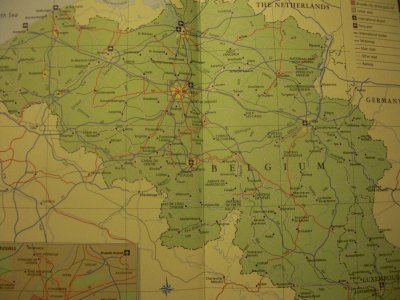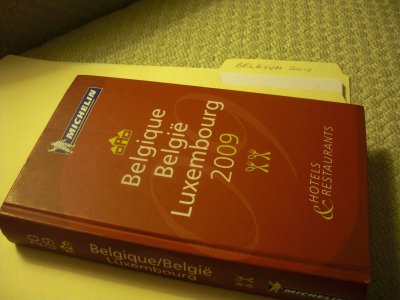 Click on this map of Belgium for a larger view with our itinerary marked. Once we've finished in Ghent, we'll drive to Ypres, then continue counterclockwise around the circuit, ending up back in Brussels to fly home.
Click on this map of Belgium for a larger view with our itinerary marked. Once we've finished in Ghent, we'll drive to Ypres, then continue counterclockwise around the circuit, ending up back in Brussels to fly home.Planning ahead: 2010 in Belgium
Written 6–11 June 2010
News flash! We're not going to France. For the first time in at least 10 years, we will spend our entire vacation elsewhere, but not too far away. In 2010, we'll be doing southern Belgium.
It's a big travel year for David. The deep-sea meetings have always been out of phase with the also-triennial meiofauna congress, but this last cycle included a hiccup that delayed them a year, so for the first time, the two meetings will be held during the same summer. And, as luck and scheduling constraints would have it, not close enough together to fit into the same trip.
David spent last week in Norway, giving a talk at the Norwegian Institute for Water Resources in Bergen and visiting young colleague Andrew Sweetman, who, as a British student, visited David's lab a few years ago. Andrew's now based at the NIWR (which calls itself NIVA in Norwegian) and took advantage of David's travel to Reykjavik for the deep-sea meetings to invite him to make the side trip. As I write, he's in Iceland, at the 12th Deep-sea Biology Symposium. If all goes well and the volcano behaves itself, he'll be home a week from today.
Then, later in the summer (and again barring volcanic eruption), he'll be off to Europe again, and that time, I'll get to go along! FourtIMCO, the 14th International Meiofauna Congress will be held in Ghent, Belgium, this year. Read my account of the 13th congress (in Recife, Brazil) in my 2007 travel diary "Brazil with the Meiobenthologists."
This year, for the first time, the meeting will be held in a "repeat" location—we attended FIMCO, the 5th congress, in Ghent in 1983. In those days, I was unaware of the internet, didn't have a computer (or a digital camera), and didn't keep on-line diaries. Maybe one of these days, I'll transcribe my handwritten account of that time . . . .
So this year, we'll fly into Brussels a few days early to get over our jet lag and to check out the local sights, chocolate, "moules frites," and Jacques Breliana, then adjourn to Ghent for the meeting, then rent a car, tour the French-speaking portion of Belgium, and spend a couple of days in Luxembourg.
 Click on this map of Belgium for a larger view with our itinerary marked. Once we've finished in Ghent, we'll drive to Ypres, then continue counterclockwise around the circuit, ending up back in Brussels to fly home.
Click on this map of Belgium for a larger view with our itinerary marked. Once we've finished in Ghent, we'll drive to Ypres, then continue counterclockwise around the circuit, ending up back in Brussels to fly home.
 Making reservations has been different. First, we've come to rely pretty heavily on the Gault-Millau guide for restaurant recommendations, and we don't have a Belgian G-M (if one even exists), so we fell back on Michelin, who conveniently publish Belgium and Luxembourg in a single volume. Second, the density of highly rated restaurants is lower in this region, so we've decided to cut back a little (especially because the euro is so high) and to concentrate on Michelin one-stars and runners up. Third, this language thing—we'll be spending some of our time in the Flemish-speaking areas or just along the language boundary, and my memory from 1983 is that, in the Flemish-speaking areas, English went over better than French, which seemed to stir up old resentments.
Making reservations has been different. First, we've come to rely pretty heavily on the Gault-Millau guide for restaurant recommendations, and we don't have a Belgian G-M (if one even exists), so we fell back on Michelin, who conveniently publish Belgium and Luxembourg in a single volume. Second, the density of highly rated restaurants is lower in this region, so we've decided to cut back a little (especially because the euro is so high) and to concentrate on Michelin one-stars and runners up. Third, this language thing—we'll be spending some of our time in the Flemish-speaking areas or just along the language boundary, and my memory from 1983 is that, in the Flemish-speaking areas, English went over better than French, which seemed to stir up old resentments.
But David put together an itinerary and list of restaurants, and I set about lining them up. Strangely, although virtually every establishment has a website, a surprising number of the restaurants—more than half—specify that they accept reservations only by telephone. And complaints about Michelin's slowness in updating its entries seem justifed—so far two restaurants turn out to be closed on the days we had chosen, even though Michelin said they'd be open. A third was already booked up for the date. Back to Michelin for replacements. On the other hand, restaurants of these more modest ratings seem to be much less wary of no-shows—they can apparently make up any deficits in walk-in trade. A couple of the hotels have wanted credit-card numbers to guarantee reservations, but not one of the restaurants wanted a credit card or a confirming call a couple of days in advance. Only two (the highest rated) have even asked me for a phone number! That suits me fine—we don't have a fax, and I don't like putting credit-card info in an e-mail, so I have to send it by snail-mail—and those confirmation calls are a royal pain. Not only do I have to remember to make the right ones on the right days, but I have to find a phone and figure out the local dialing conventions (or how to get an outside line from the hotel room). I hate 'em. And so far, every place I've called has answered in cheery French; I was afraid I'd sometimes get Flemish, and I hate having to ask, "Do you speak English?" It seems so . . . American!
The only other glitch is that the rental-car office in Ghent is closed on Sunday, which is when we wanted to pick up our car. So we'll have to pick the car up on Saturday (before noon, as even then they're only open half days), during a symposium that David's scheduled to attend—and we both have to be there in person to rent the car! Only after much to-ing and fro-ing with the travel agent did we get it all squared away, and only after that did it occur to me that we probably should have just taken a Sunday-morning train back to Brussels and picked up the car there, where the rental office at the airport is surely open seven days. Oh, well.
So now all the reservations are made, and the fun research can begin. I always start with the food, of course. Unaccountably, our home library doesn't include a Flemish-English dictionary, so I've been accumulating a little glossary for myself. Although the reservations for our touring period seem to be mostly at francophone establishments, I remember from 1983 facing a lot of Flemish-only menus at lunch and supper places during the meeting. I still regret missing out on the local take on steak tartare; when I asked the waitress what a "sandwich kannibal" was (it was on most lunch menus), she translated it only as "meat," which seemed uninteresting. This time, I'll be watching for it. It will also be great to be back in a country where they realize that the best sauce for french fries is not ketchup but mayonnaise!
I've discovered, to my delight, that Google Images is almost as good as a dictionary, at least with respect to food items. It instantly revealed that "gerookte paling" is smoked eel, a "konijn" is a rabbit (it even supplied amazing photos of large heron eating a small rabbit), "kippen" are chickens, "garnaal" are prawns, "varkenvlees" is pork, and "knoflook" is garlic. Lots of the terms are cognates if you squint a little: "vlees" is flesh, and "waterkers" is watercress. Once the glossary seems complete enough, I'll both print myself a copy for my purse and put it on the Kindle.
List of Entries next entry